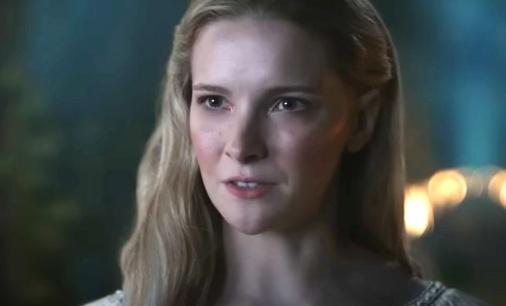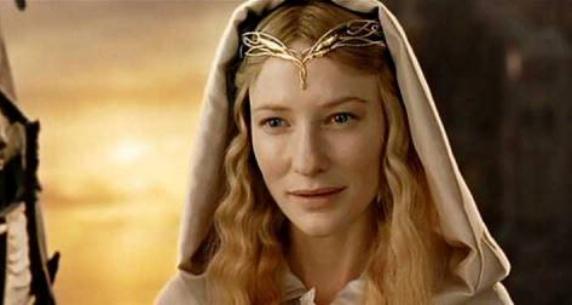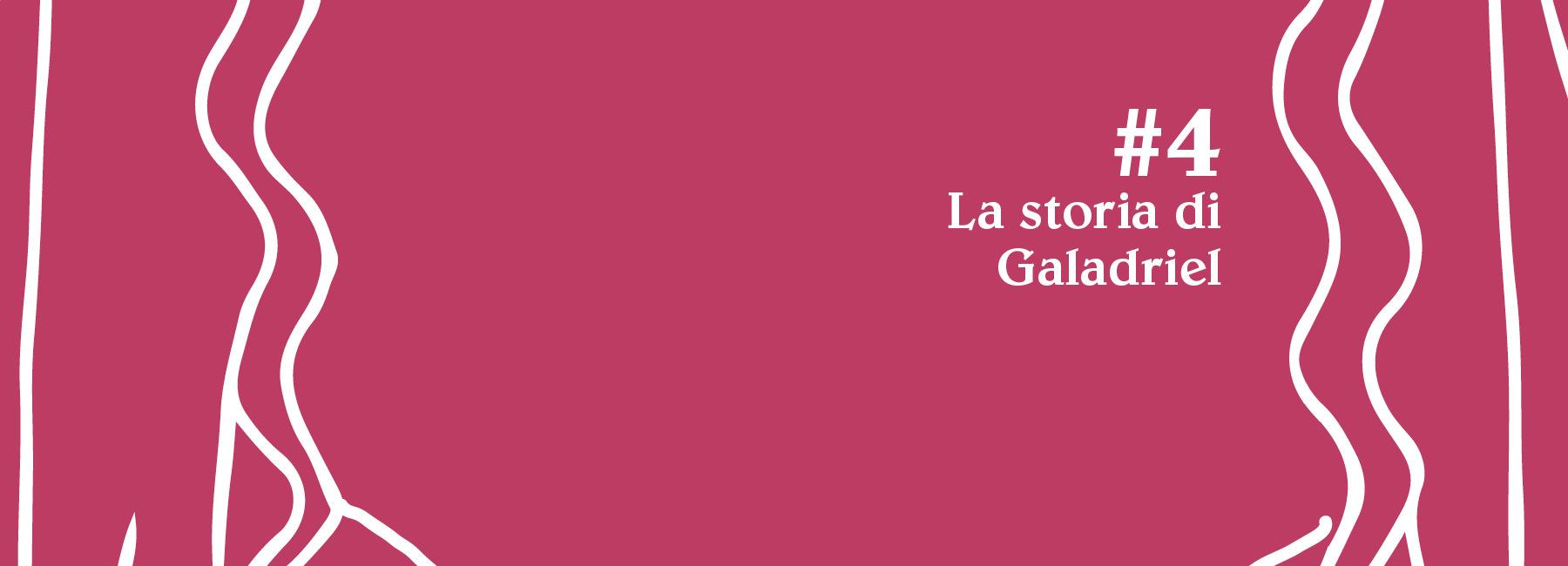di Benedetto Ardini
Galadriel all’interno della metafisica degli Elfi (1959-1966)
TESTI TRATTATI IN QUESTA SEZIONE
(* anno indicativo A.A. Anno degli Alberi ? elemento non chiaro – elemento non presente nel testo)

CONCETTO CHIAVE: Tolkien calcola le età di Galadriel nei momenti fondamentali della sua storia (l’Elfa raggiunge la “maturità” alla fine della Terza Era)
Dalla fine degli anni ’50 Tolkien ritornò seriamente sulla scrittura di quello che sarebbe dovuto diventare il Silmarillion ma che, di fatto, non riuscì mai a finire prima della sua morte. Come ci dice il figlio Christopher, il Professore si addentrò in uno sviluppo (il più possibile coerente) della metafisica del suo legendarium72. All’interno di questo quadro abbiamo i tre testi Time Scales and Rates of Growth, Difficulties in Chronology e Ageing of Elves73 che sono tutti riportati in The Nature of Middle-earth da Carl Hostetter e possiamo datare attorno al 1959. In questi lavori Tolkien trattò il problema dell’invecchiamento delgi Elfi assunto essere 100 volte più lento di quello degli uomini nel Beleriand/Terra di Mezzo (rate 1:100) e 144 volte nel Reame Beato (rate 1:144)74. Nella trattazione Tolkien considerò anche il calcolo dell’età di Galadriel nel corso della sua storia dandoci queste informazioni:
- Galadriel nasce nel Reame Beato circa nel 1475° Anno degli Alberi75 (questa data deducibile dai conti è in contraddizione con quanto Tolkien aveva scritto circa un decennio prima negli Annals of Aman in cui la data era 1362)
- parte in Esilio con gli altri Noldor a circa 20 anni (nel 1495 Anno degli Alberi), questa età corrisponde a 20×144=2880 anni solari
- arriva nel Beleriand a circa 21 (anno più anno meno)76, età corrispondente a 21×144=3024 anni solari
- alla fine della Prima Era Galadriel ha 28 anni circa77, corrispondente a 3024+590=3614 anni solari (dal momento in cui giunge nel Beleriand iniziano gli anni del Sole e da questo momento fino alla fine della Prima Era, con la caduta di Morgoth, passano 590 anni solari che per un elfo sono circa 6 anni)
- alla fine dell’Ultima Alleanza Galadriel ha 28+34=62 anni78 (corrispondenti a 3614+3441=7055 anni solari) perché la Seconda Era dura 3441 anni solari che vuol dire aggiungere circa 34 anni di invecchiamento per un elfo
- alla sua partenza dalla Terra di Mezzo Galadriel ha circa 92 anni79 (corrispondenti a 7055+3021=10076 anni solari) perché la Terza Era dura 3021 anni solari, che significano circa 30 anni per un elfo
Interessante è il commento di Tolkien che ci dice che un elfo a 92 anni ha approssimativamente passato l’apice della pienezza corporea.
Questi testi, in accordo con Concerning Galadriel and Celeborn, ci danno l’informazione che Galadriel incontri Celeborn nel Beleriand e che i due si sposino subito dopo la Caduta di Morgoth (probabilmente prima di andare nell’Eriador)80. Come nel testo The Elessar, emerge ancora il concetto che Galadriel non voglia tornare all’Ovest perché le era concesso solo di dimorare in Eressëa e non nel Reame Beato81.
Insieme a questi sviluppi è particolarmente interessante una nota, scritta da Tolkien più o meno nello stesso periodo, in cui viene detto che nei primissimi anni della Seconda Era (fino all’anno 10-20) Galadriel e Celeborn dimorarono nel Lindon e che, solo dopo la loro partenza, Gil-galad divenne Re di quel reame82.
Questo potrebbe essere il primo riferimento ad un periodo di insediamento di Galadriel e Celeborn nel Lindon che verrà poi inserito nelle Appendici della seconda edizione di The Lord of the Rings. Inoltre è interessante il fatto che Gil-galad sia sottoposto rispetto a Galadriel e Celeborn. Questo richiama la parte del materiale su Concerning Galadriel and Celeborn dove questi vengono considerati High Lady e Lord degli Elfi dell’Eriador: sembrerebbe un’idea coerente di dare sempre più spessore al personaggio di Galadriel a discapito dell’Alto Re Gil-galad.
Delle opere riguardanti la metafisica degli Elfi abbiamo un altro testo del 1965 chiamato Elvish Ages & Númenórean83. Al contrario dei lavori di circa 5 anni prima viene introdotto il concetto di growth-years (GY) e life-years (LY): i primi sono gli anni dell’infanzia e pubertà (fino a completa crescita a 24 GY), i secondi sono gli anni della giovinezza e maturità. 1 GY viene fatto corrispondere a 3 anni solari nel Beleriand/Terra di Mezzo (in Aman i GY sono uguali ai LY) mentre 1 LY a 144 anni solari84. Seguendo queste nuove “regole” Tolkien ricalcola le età di Galadriel nel corso della sua vita:
- Galadriel parte dal Reame Beato a 20 anni
- raggiunge il Beleriand a 21 anni
- in 9 anni solari dopo l’arrivo raggiunge la completa crescita (9 anni solari sono 3 GY che sommati a 21 fanno 24 GY)
- alla fine della Prima Era (circa 591 anni dopo la sua completa crescita)85 per lei passano solamente circa 4 LY (dato che 591/144 fa circa questo valore) quindi a questo stadio ha circa 28 anni
- nella Seconda Era per lei passano circa 23 LY (3441/144=23.90): Tolkien nel testo arrotonda per difetto), quindi arriva a 51 anni
- nella Terza circa 21 LY (3021/144=20.98: in questo caso Tolkien arrotonda per eccesso) ovvero arriva a 72 anni
Come ci dice il testo per fare un’equivalenza di questi numeri con l’età degli uomini mortali basta moltiplicare l’età elfica per ¾: questo comporta che alla fine della Prima Era Galadriel abbia 21 anni, alla fine della Seconda 38 anni e alla fine della Terza 54 anni86. Particolarmente interessante è il commento di Tolkien su quest’ultima età: “ha appena passato la giovinezza ed è entrata nella maturità. Questo suona bene”87. Il testo inoltre, in accordo con gli altri di questo periodo, ci da l’informazione sul matrimonio di Galadriel e Celeborn collocato all’inizio della Seconda Era e sul fatto che inizialmente vadano a dimorare nel Lindon88: quest’ultimo particolare è quello che venne inserito nelle Appendici di The Lord of the Rings a partire dall’edizione del 196689 (al posto della precedente edizione in cui già all’inizio della Seconda Era Galariel e Celeborn dimoravano a Lórien).

“The Lord of the Rings: The Ringsof Power”

72“It seems not to have been until the end of the 1950s that he turned again seriously to the Silmarillion narrative (for which there was now an insistent demand). But it was too late. As will be seen in the latter part of this book, much had changed since (and, as I incline to think, in direct relation to) the publication of The Lord of the Rings and its immediate aftermath. Meditating long on the world that he had brought into being and was now in part unveiled, he had become absorbed in analytic speculation concerning its underlying postulates. Before he could prepare a new and final Silmarillion he must satisfy the requirements of a coherent theological and metaphysical system, rendered now more complex in its presentation by the supposition of obscure and conflicting elements in its roots and its tradition.” (The History of Middle-earth, vol.10, Morgoth’s Ring, Foreword, pag.viii, Ebook Edition © August 2021 ISBN: 9780008363697)
73Del testo Time-scales and Rates of Growth viene detto “It dates from c. 1959.” (The Nature of Middle-earth, Part One: Time and Ageing, ch. IX Time-scales and Rates of Growth, pag.64, Ebook Edition © September 2021 ISBN: 9780008387938). Del testo Difficulties in Chronology viene detto “I therefore think the text in fact dates, like so many others in the “Time and Ageing” file, from c. 1959.” (The Nature of Middle-earth, Part One: Time and Ageing, ch. X Difficulties in Chronology, pag.70, Ebook Edition © September 2021 ISBN: 9780008387938). Del testo Ageing of Elves viene detto “It dates from c. 1959.” (The Nature of Middle-earth, Part One: Time and Ageing, ch. XI Ageing of Elves, pag.75, Ebook Edition © September 2021 ISBN: 9780008387938).
74“In all the earlier legends, therefore, the rate 100 : 1 can be used to determine approximately the age of any of the Eldar in human terms (except while they were in Aman where it is 144 : 1).” (The Nature of Middle-earth, Part One: Time and Ageing, ch. IX Time-scales and Rates of Growth, pag.65, Ebook Edition © September 2021 ISBN: 9780008387938)
75In questi testi viene detto che ha 20 anni all’Esilio dei Noldor: si vedano “Galadriel is known to have been “young and eager” at the Exile in 1495. If she was then 20, she would be 22 at the end of 1496 […]” (The Nature of Middle-earth, Part One: Time and Ageing, ch. X Difficulties in Chronology, pag.72, Ebook Edition © September 2021 ISBN: 9780008387938), “Thus Galadriel was just mature, 20 [life-years], at the Exile in [VY] 1495.” (The Nature of Middle-earth, Part One: Time and Ageing, ch. XI Ageing of Elves, pag.77, Ebook Edition © September 2021 ISBN: 9780008387938) e “At the exile she was young and eager, just at or upon the threshold of maturity: probably in age about 20.” (The Nature of Middle-earth, Part One: Time and Ageing, ch. IX Time-scales and Rates of Growth, pag.66, Ebook Edition © September 2021 ISBN: 9780008387938). Nel testo Difficulties in Chronology viene detto che un Elda nato nel 1475 dovrebbe avere 20 all’Esilio dei Noldor “an Elda born in Aman in 1475 would be 20 at the Exile, 21 at arrival in Middle-earth, + 590/100 [older] at the fall of Morgoth = about 27.” (The Nature of Middle-earth, Part One: Time and Ageing, ch. X Difficulties in Chronology, pag.70, Ebook Edition © September 2021 ISBN: 9780008387938). Pertanto ricaviamo l’informazione che Galadriel sia nata attorno al 1475° Anno degli Alberi.
76“[…] she would be 22 at the end of 1496 […]” (The Nature of Middle-earth, Part One: Time and Ageing, ch. X Difficulties in Chronology, pag.70, Ebook Edition © September 2021 ISBN: 9780008387938). Nel testo Time-Scales and Rates of Growth invece si suppone che Galadriel arrivi nel Beleriand all’età di 20 anni dato che alla fine della Prima Era viene detto che ne ha 26 (si veda la nota successiva)
77“[…] by Bel. 590 at the destruction of Beleriand only about 6 years older, say 28.” (The Nature of Middle-earth, Part One: Time and Ageing, ch. X Difficulties in Chronology, pag.72, Ebook Edition © September 2021 ISBN: 9780008387938). “She was then about 26 in age, for the years in Beleriand had been at the ageing-rate of 100 : 1.” (The Nature of Middle-earth, Part One: Time and Ageing, ch. IX Time-scales and Rates of Growth, pag.66, Ebook Edition © September 2021 ISBN: 9780008387938).
78“At end of SA 3441 she [Galadriel] was 28 + 34.41 years old = 62.” (The Nature of Middle-earth, Part One: Time and Ageing, ch. X Difficulties in Chronology, pag.73, Ebook Edition © September 2021 ISBN: 9780008387938).
79“At end of Third Age she was 30.21 years older – 92.62 and so approximately the time of the Prime of the hröa.” (The Nature of Middle-earth, Part One: Time and Ageing, ch. X Difficulties in Chronology, pag.73, Ebook Edition © September 2021 ISBN: 9780008387938). “[…] left Middle-earth in TA 3021. She was thus at that time in [life-]years 20 + (3441+3021)/100= 20 + 70.5, or 90 and a half years in age;[15] and thus in elven-terms, according to the time in which the “fading” of the Quendi was approaching, now passing the prime of her hröa.” (The Nature of Middle-earth, Part One: Time and Ageing, ch. IX Time-scales and Rates of Growth, pag.67, Ebook Edition © September 2021 ISBN: 9780008387938)
80“She probably married Celeborn soon after the overthrow of Morgoth,” (The Nature of Middle-earth, Part One: Time and Ageing, ch. IX Time-scales and Rates of Growth, pag.66, Ebook Edition © September 2021 ISBN: 9780008387938). Nel testo Difficulties in chronology sembrerebbe che l’insediamento di Galadriel e Celeborn nell’Eriador sia successivo al loro matrimonio: “[…] at the destruction of Beleriand only about 6 years older, say 28. She wedded Celeborn about that time and went into Eriador” (The Nature of Middle-earth, Part One: Time and Ageing, ch. X Difficulties in Chronology, pag.73, Ebook Edition © September 2021 ISBN: 9780008387938).
81“There may have been also an element of pride in her decision; for she was a princess of the Ñoldor, who had lived in Aman itself. Eressëa seemed only a “second best”.” (The Nature of Middle-earth, Part One: Time and Ageing, ch. IX Time-scales and Rates of Growth, pag.66, fn.1, Ebook Edition © September 2021 ISBN: 9780008387938)
82“[…] further detail found in still other, very rough but apparently contemporary drafting in red and blue ball-point pen: Gilgalad became king in Lindon (under [?Suz[erainty] or?Sway] of Galadriel) about SA 10–20 after departure of Galadriel and Celeborn.” (The Nature of Middle-earth, Part One: Time and Ageing, ch. XI Ageing of Elves, pag.80, Ebook Edition © September 2021 ISBN: 9780008387938)
83“The text itself is dated by Tolkien in red ball-point pen in the top margin of the first page: “15/Aug/1965” […]” (The Nature of Middle-earth, Part One: Time and Ageing, ch. XVIII Elvish Ages & Númenórean, pag.147, Ebook Edition © September 2021 ISBN: 9780008387938)
84“Elves’ ages must be counted in two different stages: growth-years (GY) and life-years (LY). The GYs were relatively swift and in Middle-earth = 3 löar. The LYs were very slow and in Middle-earth = 144 löar.” (The Nature of Middle-earth, Part One: Time and Ageing, ch. XVIII Elvish Ages & Númenórean, pag.147, Ebook Edition © September 2021 ISBN: 9780008387938). Nel testo viene poi specificato che 1 corrisponde ad 1 anno solare “[…] löar (Sun-years) […]” (The Nature of Middle-earth, Part One: Time and Ageing, ch. XVIII Elvish Ages & Númenórean, pag.148, Ebook Edition © September 2021 ISBN: 9780008387938).
85Assumendo 600 anni di durata dall’arrivo di Galadriel nel Beleriand fino alla Caduta di Morgoth.
86Per tutti questi conti si faccia riferimento al testo a pag.149 (The Nature of Middle-earth, Part One: Time and Ageing, ch. XVIII Elvish Ages & Númenórean, pag.149, Ebook Edition © September 2021 ISBN: 9780008387938).
87“In TA 3021, when she sailed West, she was about 51 + 21 = 72 (mortal equivalent 54) and had just passed her “youth” and entered “maturity”. This fits well.” (The Nature of Middle-earth, Part One: Time and Ageing, ch. XVIII Elvish Ages & Númenórean, pag.148, Ebook Edition © September 2021 ISBN: 9780008387938).
88“Early in the Second Age she married Celeborn, and dwelt first in Lindon.” (The Nature of Middle-earth, Part One: Time and Ageing, ch. XVIII Elvish Ages & Númenórean, pag.149, Ebook Edition © September 2021 ISBN: 9780008387938).
89“[…] in the headnote to the Tale of Years of the Second Age, as it appeared in the first edition: ‘many of the Sindar passed eastward and established realms in the forests far away. The chief of these were Thranduil in the north of Greenwood the Great, and Celeborn in the south of the forest.’ In the revised edition this remark about Celeborn was omitted, and instead there appears a reference to his dwelling in Lindon” (Unfinished Tales, Part Two, ch. IV The History of Galadriel and Celeborn, The Elessar, pag.242, Edition 1998).
Laureato in Ingegneria Fisica al Politecnico di Milano dove sta proseguendo la sua carriera come PhD. Fin da bambino è appassionato di Tolkien i cui libri rappresentano per lui uno stimolo e un accompagnamento fondamentali per la vita di tutti i giorni.



